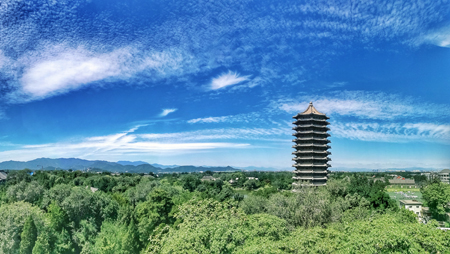Peking University, April 25, 2019: Yan Garden’s scenery has been famously described as “glimmering lake reflecting pagoda.” The pagoda referenced in those lines is Peking University’s iconic Boya Pagoda, which is located in the middle of the eastern part of campus by Weiming Lake. Built in 1924, the pagoda was originally intended to be used as a water tower. Today, however, it has a different function: a campus landmark and a must-see scenic spot. Among both students and visitors, it is also one of the most popular backdrops for pictures.

Boya Pagoda, with an octagonal-base and a total of 13 stories, stands 37 meters high. The architecture features densely positioned, articulated dougong in the eaves, which is typical of the multi-eave pagodas of the Liao and Kin dynasties. Boya Pagoda is hollow with an inner spiral staircase winding from the bottom all the way to the top. Unfortunately, visitors are not allowed to enter it for security reasons. Like many other buildings that made up the original Yenching University (which later became Peking University), Boya Pagoda is an example of traditional Chinese architecture built in western way. The whole pagoda is constructed of reinforced concrete except its stone base.
The name of the Boya Pagoda is associated with Bo Chenguang (Lucius C. Porter), who was an American professor of Philosophy at Yenching University. His uncle, James Porter, funded the Boya Pagoda. Lucius Porter was deeply influenced by traditional Chinese culture and had worked at the Peking office of the Harvard-Yenching Studies Institute. More importantly, his progenitors had done a great deal to develop Tongzhou Union University, one of the predecessors to Yenching University. When Yenching University started constructing a water tower to add to streams inside campus, people wanted to commemorate these historical origins and specifically the shape of the famous pagoda of Tongzhou, Dīpankara Buddhist Śarīra pagoda (the Randeng pagoda). Because Yenching University had a tradition of naming a building after its funder, the pagoda was then named Boya. “Bo” refers to the first character in Porter’s Chinese name, and “Ya” implies an “elegant scholar.” In English, the pagoda is sometimes simply called “Porter’s Pagoda”.
Today, students often say that no building higher than Boya Pagoda is allowed to be built in Yan Garden. Even though it is not true, the tale shows that Boya Pagoda remains an important spiritual symbol for PKUers. Although it is beautiful every day, everyone agrees that during festivals, such as the mid-autumn festival or the lantern festival are the best time to enjoy it. If you happen to be on campus during those times then congratulations! You will have the precious opportunity to see a stunningly lighted Boya Pagoda. Everyone who sees it is impressed by the spectacular view.
Works Cited:
Do you really know Boya Pagoda? yychBeidaRelics, 1 March 2018, pku.org.cn/memory/yyfw/81856.htm
Renzhi Hou, “I Come from Yenching University” Symposium on Chinese Historical Geography. Foreign Language Teaching and Research Press/Springer- Verlag Berlin Heidelberg, 2015
Written by: Yang Hongyun
Photo Credit to: Zeng Liang
Edited by: Erin Dunne
